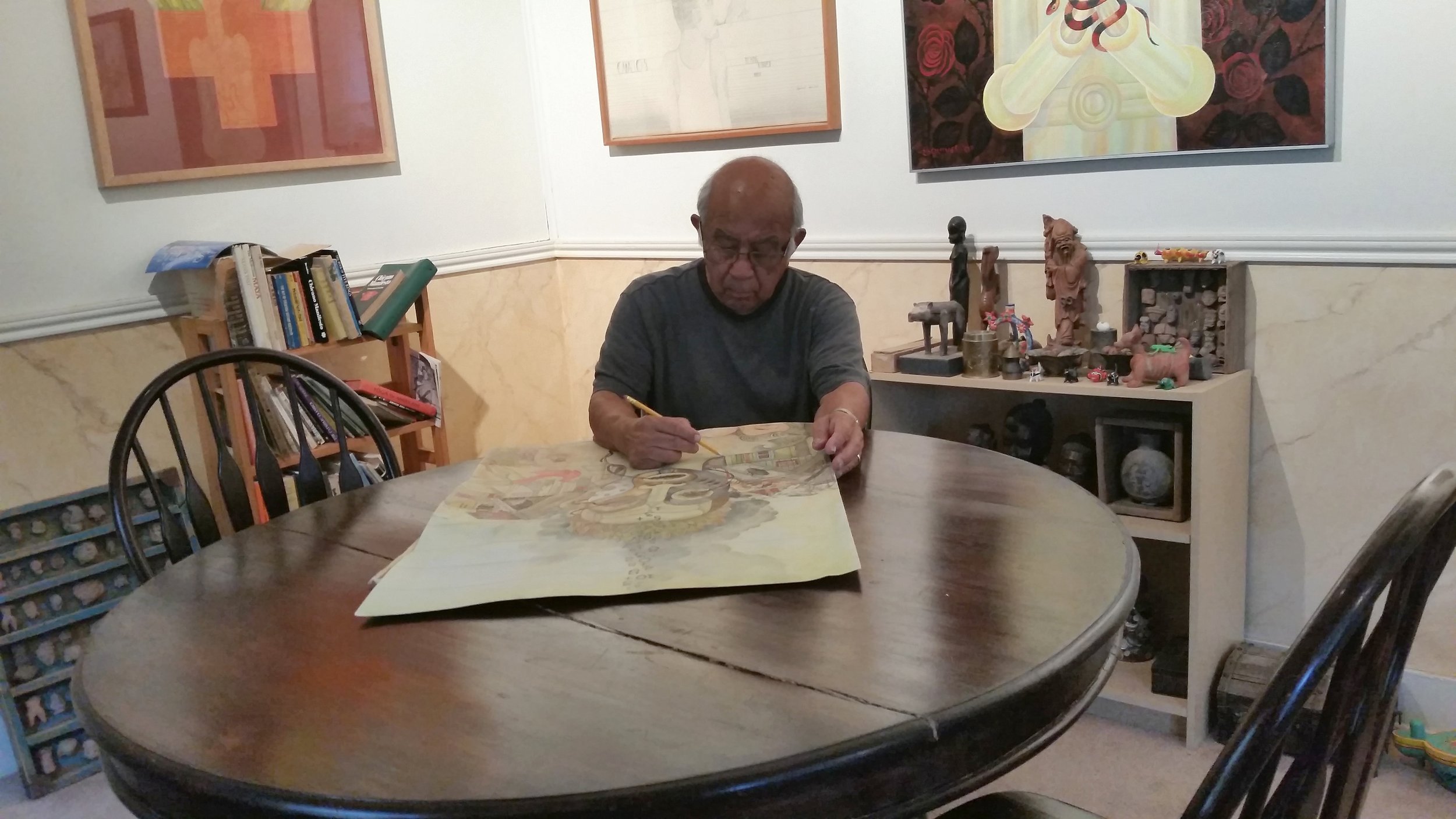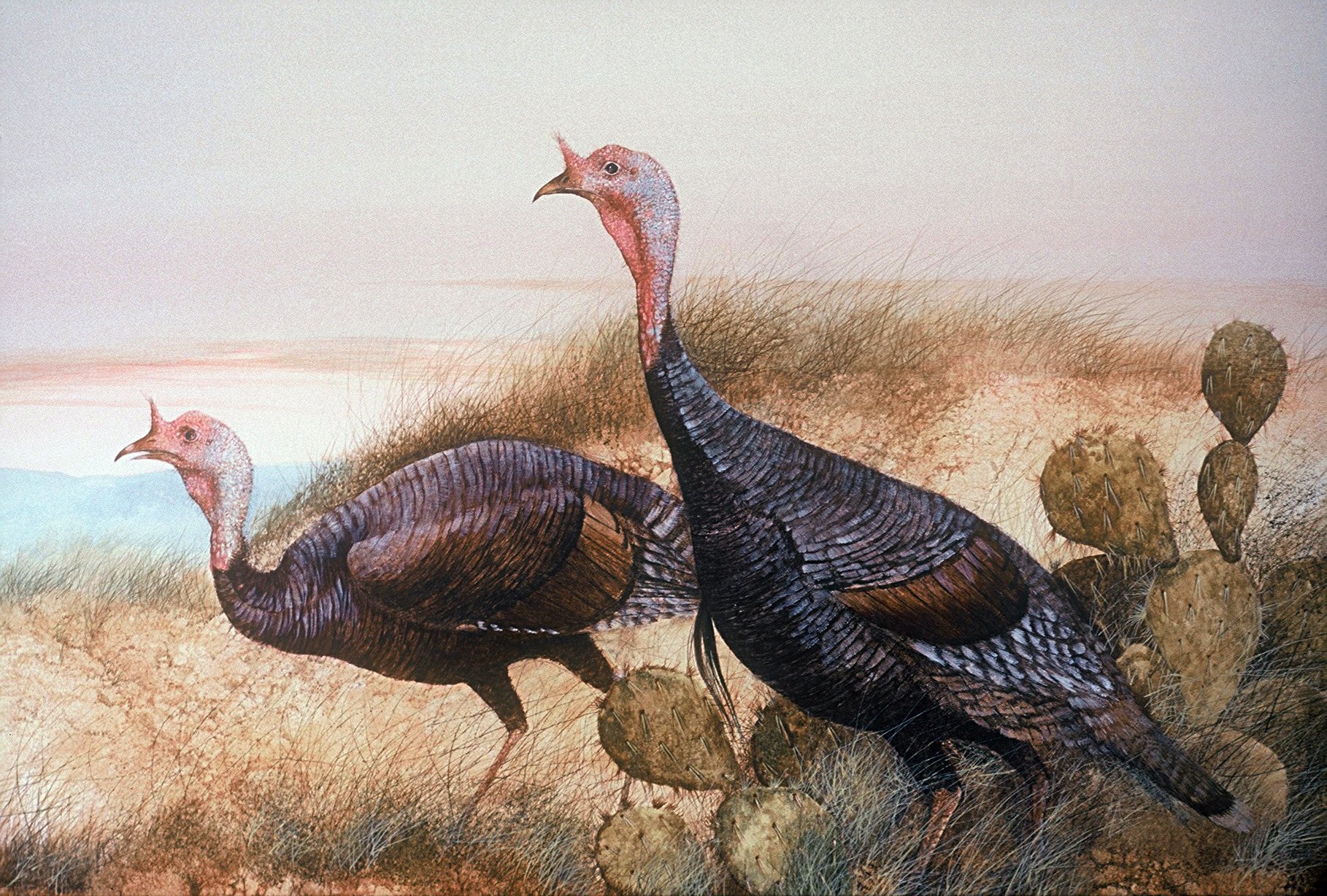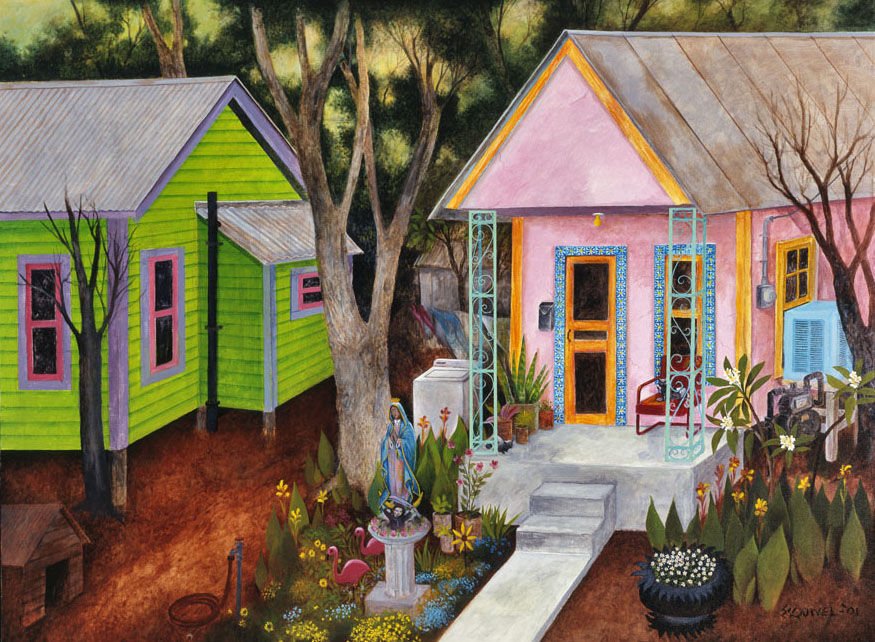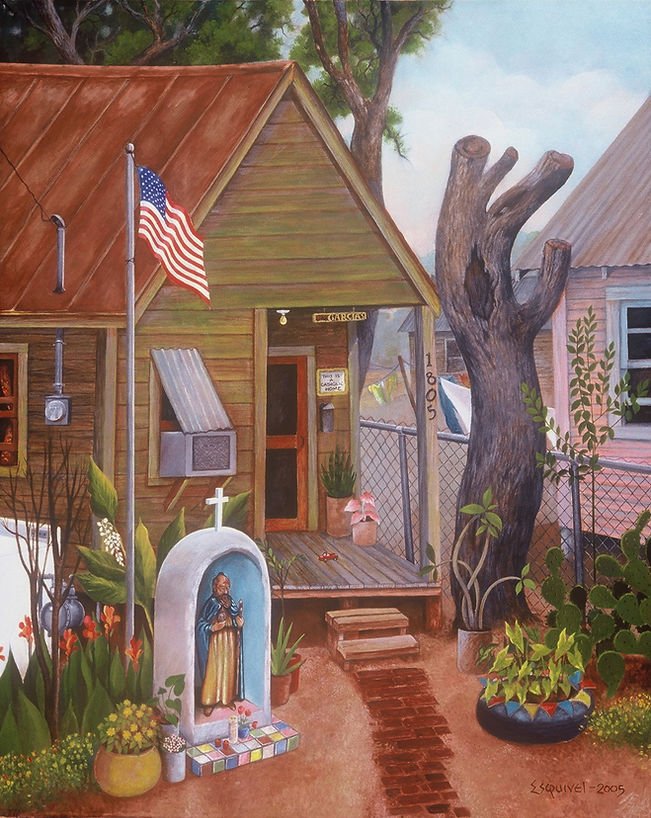…And the Barrio Did Not Devour Me
San Antonio-based Chicano artist José Esquivel highlights a career spanning over 50 years
Detail from Self-Portrait (2006) by José Esquivel, acrylic on canvas. Courtesy of Mario Esquivel, Art Representative of José Esquivel
HTI Open Plaza presents a photo essay based on a Q&A with José Esquivel, highlighting a career in the graphic and fine arts that spans over 50 years. His early work is strongly influenced by the Chicano socio-political movement of the 1960s and 1970s, providing a direction that continues to this day.
NOTE: A third-person version of this essay appears as an Artspace Teen Council blog by Central Catholic High School student Ernesto Gómez (21 February 2021). All images and text in the expanded Open Plaza version are courtesy of José Esquivel and Mario Esquivel, Art Representative of José Esquivel.
ARTIST STATEMENT
It’s my main objective as an artist and communicator to express my point of view and articulate visually our cultural realities and social concerns. My paintings are barrio scenes that are reminders and memories of familiar places. The symbolism depicts some of our cultural beliefs and also the condition and struggles of a segment of people in our society.
—José Esquivel
INSPIRATIONS
In general, I enjoy a backdrop of Western Classical or Jazz music when I paint.
However, my playlist is varied and eclectic—from composer-violinist Gustavo Dudamel to singer Luis Miguel. Notable inspirational tracks are “Blackbird” by the Beatles and “Strange Fruit” by Billie Holiday.
Inspired by the Little Joe & La Familia song, “Las Nubes” represents the farm worker. The composition brings into frame visual snapshots that show the strong spiritual ties of the worker, their families, and the everyday environment they live in.
Las Nubes (2016) by José Esquivel; acrylic on canvas; 30” x 40.” Photo: Lee Young
FORMATION
I attended San Antonio Public schools and took commercial art under the direction of Katherine Alsup at Technical and Vocational High School. She recognized my natural talents and enthusiastically encouraged me to realize that I could make a career in the arts field. I entered and won local art competitions that gave me confidence in my abilities and talents to move forward in the arts. I applied for and was awarded a full scholarship to the Warren Hunter School of Art in 1954 and graduated in 1958 with a Certificate of Completion in Commercial Arts.
As a fine artist, I was influenced by the masters—Diego Rivera, Rufino Tamayo, and Francisco de Goya—fascinated by their ability to tell a story, expressing sociopolitical themes and skillfully rendered compositions. My work is based on different themes and symbolism based on real experiences in my life, familiar places, neighborhood memories, and the sociopolitical impact of the community in the west side of San Antonio, where I grew up.
After graduating from the Warren Hunter School of Arts, I began my commercial arts career freelancing. I did commercial work for several companies: Mark French Display Company, South Western Decal Company, and Sommers Drug Store. I specialized in hand-lettering, poster design, and in-store displays.
In 1957, I was hired full-time as a commercial artist at City Public Service. With additional support staff, the department became a full service in-house art department. I managed and gave creative direction for corporate and consumer printed materials. After serving 29 years, I retired from City Public Service as a Supervisor of the Art Department. I left the corporate life to devote my creative energies and passion as a fine artist.
As an artist, I have been involved in the San Antonio art scene since the 1960s. I’m very proud of my participation in numerous noted exhibits, including: the historical “Dale Gas” Chicano Art Exhibition, held at the Houston Contemporary Arts Museum in 1977; the International Latina/o Arts Festival, in Scottsdale, Arizona; and the Humboldt-Universität zu Berlin’s Thaer-Institut in Germany.
“Joe” Esquivel (right) and fellow Tech High School student Becky Ramon, shown in the 1950s with art instructor Katherine Alsup (center), putting finishing touches on their “Life in America” paintings. Done under the international Junior Red Cross Art Program, the paintings would be on display at River Art Gallery and later sent abroad.
Esquivel, commercial artist at City Public Service, 1961
Puffing Away by José Esquivel, shown left ca. 1970.
José Esquivel with his work [The Same Puddles] Los Mismos Charcos (2000), acrylic on canvas, 20”x16, at the Thaer-Institute, Humboldt-Universität zu Berlin, Germany, 2018.
THE CHICANO MOVEMENT
Between 1967 and 1968, a group of friends met to discuss the forming of a Chicano art group known as El Grupo. Our members included Jesse Almazán, Jesse Cantú, José Esquivel, Joe Garza, José Garza, Felipe Reyes, and Roberto Ríos. Recognized nationally as one of the first Chicano artist collectives in the country, we came together to exchange ideas and to interpret the Chicano Movement artistically.
In 1971, with the addition of new members and a new mission, El Grupo transitioned their name to Con Safo. [The name is derived from Spanish zafarse, “an old barrio term that conveys an attitude of sneaking out of difficult situations,” according to former member Mel Casas. In addition to José Esquivel, other members of Con Safo included Carmen Lomas Garza, Santos Martínez, Amado Maurilio Peña, Felipe Reyes, Roberto Ríos, Rudy Treviño, and Vincente Velásques.] We worked to establish a Chicano philosophy and approach to our work. We wanted inclusion in the community art scene, seeking venues that would showcase our art.
El Grupo included (l. to r.): Felipe Reyes, José Esquivel, Jesse Cantú, Roberto Ríos
Con-Safo artists included (l. to r.): Santos Martínez, Jesse Almazán, Roberto Ríos, Felipe Reyes, José Esquivel, Vincente Velásques, Mel Casas, and José P. Garza
In 1975, I left the Con Safo group to pursue a different direction in art. I explored southwestern themes, wildlife, and landscape paintings that I call decorative art. These works were more of a commercial nature at the time. Although I enjoyed this period, I was more enthusiastic and excited to create an emerging series of “social-realism” work.
Wildlife painting by Jose Esquivel, circa 70’s
“Barrio USA Series” logo designed by Jose Esquivel in the 1990s.
BODY OF WORK
In 1991, I returned to complete and interpret social and political themes. “Barrio USA” is the brand name I coined back the early 1990’s. The social-realism series takes root in my experiences and view of issues that relate to the neighborhood where I grew up, covering topics like immigration, and the economic impact and environmental conditions of a segment of our community.
El Mundo de Elenita Cruz (2007) by Jose Esquivel; acrylic on canvas, 24”x36”. Collection of the National Museum of Mexican Art, Chicago, Illinois. Photo: Lee Young
“El Mundo de Elenita Cruz” is a portrait of my grandmother. Elenita left the town of Bustamante, Mexico with my father, who was nine years old at the time, to the United States. They came here legally to seek a better life, first settling in Laredo, Texas, and finally moving to San Antonio. She was a spiritual warrior who believed that bad spirits could be overcome through prayer and positive thinking. The composition portrays symbolic elements of her world and pays homage to the strong woman she was in spirit and inspiration. The original painting is at the National Museum of Mexican Art Collection in Chicago, Illinois.
The Dreamers/Dreamers in Space (2014) by Jose Esquivel; acrylic on canvas, 48”x60.” Photo: Lee Young
Another favorite work is “The Dreamers,” completed in 2014 and inspired by the Deferred Action for Childhood Arrival (DACA) Act, which allows some individuals with unlawful presence in the United States after being brought to the country as children [“Dreamers”] to receive a renewable two-year period of deferred action from deportation and become eligible for a work permit in the U.S. The painting depicts Dreamers suspended in outer space, not knowing where they belong or where their future lies in our society.
Click on each work for additional commentary.
LO COTIDIANO
I keep busy on variety of creative projects and spend quality time at my Westside studio. Currently, I have several works at different stages of completion. When I want to find some Zen time, I’m usually at my Lakehills house studio, which I am currently renovating.
During down time, I enjoy sketching and taking in fresh air. I also enjoy spending time connecting with my family, friends, and colleagues. For the most part, I keep in touch through social media, including Facebook and Instagram.
As far as hobbies and interests, I like watching documentaries about different cultures, and I enjoy reading—yes, actually holding a book! My reading interests vary, from Pre-Colombian culture and Western/Eastern philosophy to health and wellness.
The last book I read was The Power of Now: A Guide to Spiritual Enlightenment by Eckhart Tolle. A book that has inspired me is the 1971 novel …Y no se lo tragó la tierra [...And the Earth Did Not Devour Him] by Tomás Rivera.
As to my favorite foods, they are: caldo de res and chicken mole (my late wife’s family recipe, the perfect blend of flavor and spice).
I seek and enjoy collecting African carvings, ancient Mexican Indian figuras de barro, and vintage metal toys. I like objects that are handmade.
Day to day, there is no norm. I approach each day ready to produce, create, or accomplish. Always, new goals to reach. I also have an exhibition in Canada [“XICANX,” Museum of Anthropology, University of British Columbia] this year that I am looking forward to.
I am student of the world, enjoying life with all its possibilities.
Esquivel with his African masks and carvings collection
Esquivel’s collection of ancient Mexican Indian figuras de barros [clay figures]
My website is joseesquivel.com, and everyone reading this is welcome to visit. Send me your comments—I would love to hear from you.































